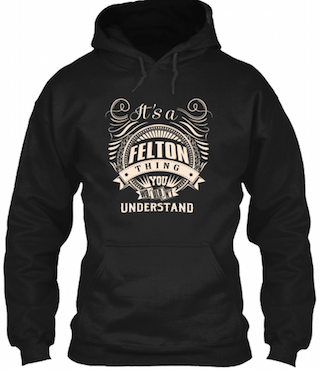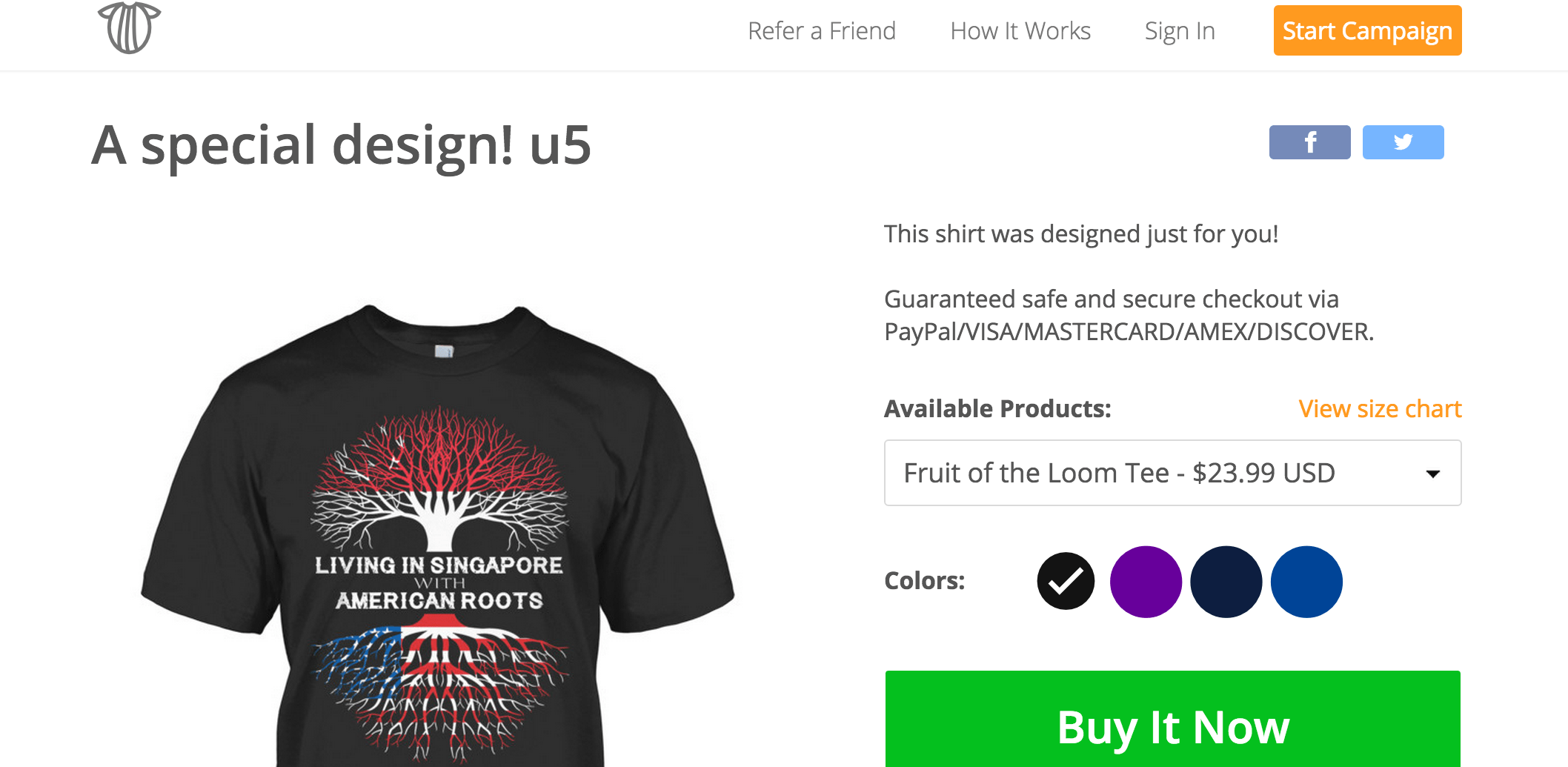Ever wonder why ads for a particular pair of socks keep following you around the web? Or why that one person you hardly know keeps showing up in your news feed when your old friends rarely seem to appear?
All these questions come back to data, and the algorithms that process it. This is the first instalment of the Living With Data series, which explores how our online data is tracked, collected, and used in our everyday lives.
I pay more attention to targeted advertising than most people, in large part because I consider ads to be some of the clearest signals we have for understanding how our data can be used.

Take this ad I recently saw for a very specific t-shirt for American citizens living in Singapore (left).
I came across it the other day as a sponsored post in my Facebook news feed. It caught my attention, given how on point it was — It’s true, I am an American, just recently moved to Singapore. However, I’m not the type to wear my passport on my sleeve.
Still I wondered, what data and what advertising processes made it possible for this very-long-tail item to find its way to my eyeballs?
How did this hyper-targeted ad reach me? And was it algorithmically generated content to begin with?
I had seen these kinds of targeted t-shirts before when my mum sent around an email with a sweatshirt, claiming proudly “It’s a Felton thing,” to me and her sisters. “I saw this on Facebook for some reason — thought you might get a kick out of it. Sara will understand the algorithm about why it showed up on my page.” My mum has a lot of faith in my decoding abilities.

I checked out the site. As the campaign language goes: “If you’re a FELTON then this shirt is for you! Whether you were born into it, or were lucky enough to marry in, show your strong FELTON Pride by getting this limited edition It’s A FELTON Thing shirt today.”
I was most surprised that the ad targeted her maiden name instead of her last name, though Felton is listed in her profile. According to the TeeSpring details on this shirt, 39 prints were sold to other proud Feltons in the original campaign back in February, but you can still order another one. That’s a generous definition of “limited edition.”
I had also heard of algorithmically generated t-shirts that are printed on demand, designed to take advantage of the very-long-tail of possible search permutations. You type in a string of phrases, and that special personalised meme is there, designed, and ready for you to buy it. But the algorithms that generate these shirts don’t have the common sense to recognise that offering the slogan “Keep Calm and Rape A Lot” — as Solid Gold Bomb did on Amazon back in 2013 — is a bad idea.
With those clues as starting points, I started wondering about the Singapore ad before me. What criteria or profile details were used to target this ad? Was it based on my current location in Facebook? My membership to expat Facebook groups? What series of things had the person who bought this ad focused on to reach me so specifically?
And then I wondered, who took the time to design this t-shirt? Are there hundreds more permutations with branching trees and flag-filled roots?
Clicking Through
I looked into the URL advertised for the shirt, which led me to a page vaguely titled with what seems like an artifact of an automated process or a shoddy copy-paste job: “A special design! u5.” And the dubious promise that this shirt was designed just for me.

The shirt is being sold on TeeChip, a seller platform that makes it easy for anyone to design a shirt and market it to a wide audience. They take care of the screen printing and shipping, and all the marketing, or “campaigning” as they call it, is up to you. It sounds a little too good to be true — “Want to make money online with no risk or upfront costs?”
Walking through their directions for would-be t-shirt entrepreneurs, the process jumps from design phases to step five: make money. Sounds like an underpants gnome scheme, to me. What they don’t tell you is how to target advertisements and run campaigns so your specialised t-shirt gets in front of people willing to buy them. The success of this business relies entirely on targeted advertising of niche products.
I wanted to know more about who is selling these t-shirts, and whether anyone is making real money off them? TeeChip offers one seller success story from Sekr Zerdazi: “Eventually I started setting up Facebook ads and monitoring them. I even began dreaming about it. My mind was always thinking of new shirt ideas.” Still, the post offers nothing about how exactly Sekr has been so successful at selling these t-shirt ideas.
My Own Meta Campaign
Eager to learn by doing, I tried setting up my own campaign — a t-shirt with the screenshot of the Singapore t-shirt, of course. Nothing about the set-up process suggests that I might have to market this product if I want to make any money from it. But when I clicked through to some of the account management options after I set up the campaign, I ended up at a page with fields for Facebook Conversion Pixel, Facebook Custom Audience, Perfect Audience, and Google Analytics ID. Now I was getting somewhere.
All of these fields correspond to advertising technologies that target and track advertisements and conversions (i.e. when you buy something that you clicked on from an ad).
Facebook’s Conversion Pixel directions detail how to retarget ads based on pixels that the website manager embeds on the page — say for a specific t-shirt on TeeChip.com. Once the pixel is there, the system can recognise specific users who have looked at that page, and then uses that list to populate new ads that resurface that content from that page on other sites around the web that dynamically generate ads from Facebook’s ad network.
Perfect Audience is another cookie retargeting tool that shows an ad to a browsing customer multiple times if she choses not to buy it the first time she visits the website.
So yes, as I suspected, TeeChip enables some pretty specific audience targeting using Facebook’s advertising tools. And they make it relatively easy to set up because the fields are right there in the campaign maintenance settings. I just had to poke around to find them.
T-shirts All the Way Down?
That still didn’t answer my next question, because the sponsored post itself came from “Tee for Americans,” a Facebook page that must have bought the advertisement to show up in my news feed. And the Tees for Americans page is full of various permutations on state identities like “Just a New Jersey Girl Living in a Wisconsin World” and that FB page points to a completely different website: “SunFrogShirts.com.” This is quickly turning into a rabbit hole of personalised pyramid schemes…
Why would Tee for Americans, run by SunsFrogShirts.com, direct me to buy a shirt on what appears to be a competitive site, TeeChip? SunFrogShirts.com has nearly the same t-shirt, though reversed as Singapore roots in America, for $US19, and it’s going for $US24 on TeeChip.
When I called TeeChip support, there wasn’t much they were willing to share about their sellers and their marketing practices: “We just give them the tools.” I asked for a way to connect with the person responsible for the ad I saw on Facebook, but the customer service rep, David, said, “We can’t control that, that’s more of a Facebook claim than a TeeChip thing.” He suggested that maybe Tee for Americans was getting an up-selling commission on shirts that were sold through his targeted ad, even if he wasn’t the original seller for the TeeChip campaign.
Business models like TeeChip and TeeSpring’s are prone to these sorts of accountability issues. Plenty of customers have complained about getting charged but not receiving their items. Other forum conversations suggest that sellers on TeeChip are repurposing fan art and profiting without sharing with the original artist. While many of these platforms have systems to check for copyright infringement and profanity, they can’t control how sellers target customers throughout the web.
I did finally get an email back from a TeeChip marketing representative. Her email domain was not at TeeChip.com, but ooShirts.com. ooShirts is a lot like TeeChip, except it’s aimed at people trying to directly order custom t-shirts for things like sports teams and charity events. The rep connected me to the t-shirt designer, Nguyen Pham, after he consented to be contacted by me. She warned, however, that he was not willing to share his targeting methods as he considered them “private.”
I later heard back from Nguyen via email. He says he sells “a lot, thousands” of t-shirt designs through sites like TeeChip and SunFrog, and Tee for Americans is a Facebook page he runs to promote his business. He says he has his own designer who makes all the shirt designs; “I just tell her the ideas.” He confirmed that he uses Facebook to market these shirts because it’s more efficient than Google Adwords. And to my question about how he had specifically targeted this Singapore shirt to reach me, he wouldn’t divulge: “It’s a business secret so I can’t tell about that.”
My Data, A Seller’s Audience?
As a lowly Facebook user, it takes a lot to figure out why something is targeted to me. I know this information is somewhere in my profile or previous activity, and essentially anything I say and do on Facebook is fair game to be targeted against.
I can make some fair guesses if I know a little more about how ads can be bought and targeted on Facebook. Perhaps Nguyen was targeting people who follow the page for the American Association of Singapore. Or it could have been the fact that my Places I’ve Lived fields list only Hometown: Georgetown, Massachusetts and Current City: Singapore. Without Nguyen’s business secrets, I won’t know which American-Living-in-Singapore clue gave me away.
At best, we can go back to ignoring these ads, even when they get a little too close to where we now call home. Or if we’re really annoyed, we can tell Facebook to stop showing this particular ad by providing feedback about it. If we’re worried about how that location information might be used elsewhere, we can scrub it from our Facebook profiles, but that drastically diminishes Facebook’s ability to surface people and events that might be relevant to us. Turns out, that “current city” profile field on Facebook is actually pretty important and useful to me right now.
The long tail of personalised, hyper-targeted commerce is a wild west out there, pardners. Click carefully.
Images: Screenshot of Facebook; screenshot of TeeSpring; screenshot of TeeChip
